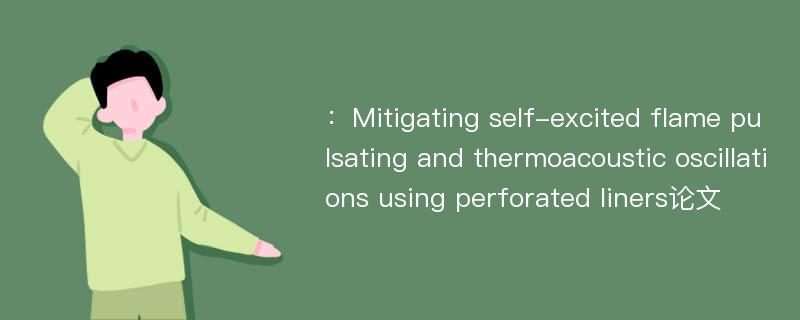
本文主要研究内容
作者(2019)在《Mitigating self-excited flame pulsating and thermoacoustic oscillations using perforated liners》一文中研究指出:Open-loop control of self-excited flame pulsating oscillations and thermo-acoustic instability is considered in this work.The performance of the control strategy is numerically evaluated in a 2 D Rij ke-type combustor with a perfo rated pipe implemented.It is found that approximately 38 dB sound pressure level(SPL)reduction can be achieved by actively tuning the cooling flow through the perforated pipe.Furthermore,the vorticity-induced damping performance is contributing to the breaking up of flame-acoustics coupling.However,the shedding of vortices is not uniformly distributed along the perforated pipe.To apply the control strategy in practice and to validate the findings,experimental studies are performed on a customerdesigned Rij ke-type combustor with a perfo rated liner implemented.To mimic practical engines,a cooling flow generated by a centrifugal pump is provided to pass through the perforated pipe.Properly tuning the cooling flow rate is found to lead to the unstable combustor being successfully stabilized.SPL is red uced by approximately 35 dB at ω1/2π≈245 Hz,and harmonic thermoacoustic modes are completely attenuating.Further study is conducted by suddenly re moving the perforated pipe section.The combustion system is found to be associated with not only classical thermo-acoustic limit cycle oscillations with a dominant mode at 2.45 × 102 Hz,but also beating oscillations at 1.4 × 1 00 Hz.It is revealed that increasing acoustic losses by implementing the perforated pipe is another critical mechanism contributing to attenuating flame pulsating instability.The present work opens up an applicable means to attenuate both selfexcited high-frequency thermoacoustic and low-frequency flame pulsating oscillations.
Abstract
Open-loop control of self-excited flame pulsating oscillations and thermo-acoustic instability is considered in this work.The performance of the control strategy is numerically evaluated in a 2 D Rij ke-type combustor with a perfo rated pipe implemented.It is found that approximately 38 dB sound pressure level(SPL)reduction can be achieved by actively tuning the cooling flow through the perforated pipe.Furthermore,the vorticity-induced damping performance is contributing to the breaking up of flame-acoustics coupling.However,the shedding of vortices is not uniformly distributed along the perforated pipe.To apply the control strategy in practice and to validate the findings,experimental studies are performed on a customerdesigned Rij ke-type combustor with a perfo rated liner implemented.To mimic practical engines,a cooling flow generated by a centrifugal pump is provided to pass through the perforated pipe.Properly tuning the cooling flow rate is found to lead to the unstable combustor being successfully stabilized.SPL is red uced by approximately 35 dB at ω1/2π≈245 Hz,and harmonic thermoacoustic modes are completely attenuating.Further study is conducted by suddenly re moving the perforated pipe section.The combustion system is found to be associated with not only classical thermo-acoustic limit cycle oscillations with a dominant mode at 2.45 × 102 Hz,but also beating oscillations at 1.4 × 1 00 Hz.It is revealed that increasing acoustic losses by implementing the perforated pipe is another critical mechanism contributing to attenuating flame pulsating instability.The present work opens up an applicable means to attenuate both selfexcited high-frequency thermoacoustic and low-frequency flame pulsating oscillations.
论文参考文献
论文详细介绍
论文作者分别是来自Science Bulletin的,发表于刊物Science Bulletin2019年13期论文,是一篇关于,Science Bulletin2019年13期论文的文章。本文可供学术参考使用,各位学者可以免费参考阅读下载,文章观点不代表本站观点,资料来自Science Bulletin2019年13期论文网站,若本站收录的文献无意侵犯了您的著作版权,请联系我们删除。
